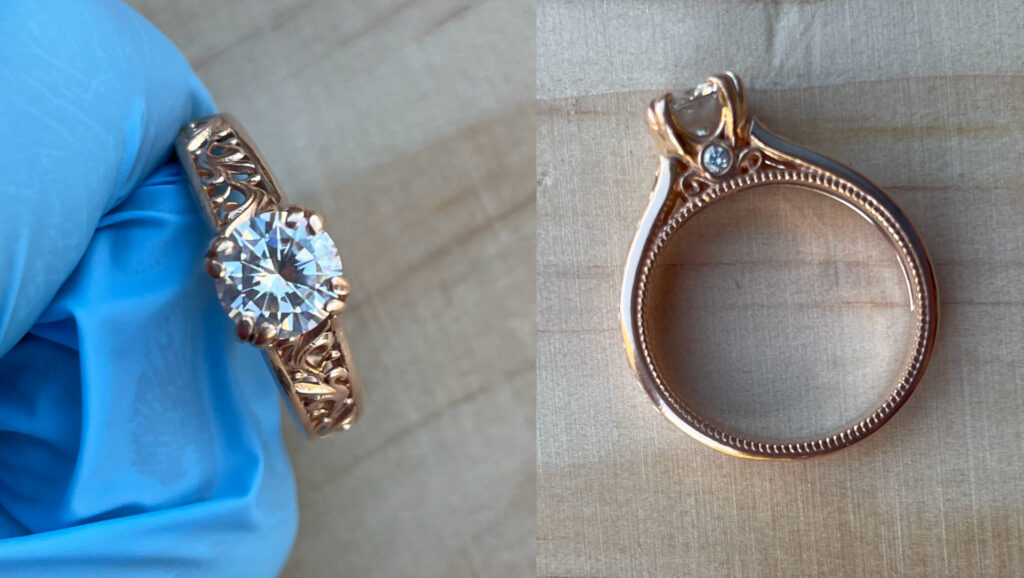This 14k rose gold engagement ring was purchased new in 2017 from Camellia Jewelry, a company located in Israel that produces custom and wedding jewelry. The center stone is a lab created moissanite and the smaller stones are conflict-free diamonds. We screened the wedding band here.
Gold can occasionally test positive for mercury and it may also test positive for cadmium. In previous decades, cadmium was used for a variety of purposes in fine jewelry and more recently in costume jewelry.
How do you think this ring tested?

Reading on the metal band:
| Element of Interest | Parts per million (ppm) | Error Range |
|---|---|---|
| None detected | ||
| Other Elements | ||
| Selenium (Se) | 661 | +/- 240 |
| Nickel (Ni) | 445 | +/- 95 |
| Copper (Cu) | 318,291 | +/- 20,592 |
| Zinc (Zn) | 2,236 | +/-196 |
| Bromine (Br) | 389 | +/- 102 |
| Iron (Fe) | 224 | +/- 95 |
| Gold (Au) | 388,872 | +/- 33,359 |
| Bismuth (Bi) | 352 | +/- 109 |
| Niobium (Nb) | 1,008 | +/- 98 |
| Silver (Ag) | 11,359 | +/- 1,107 |
| Indium (In) | 4,398 | +/- 435 |
All samples were tested in consumer goods Metals/Ceramics mode using a Niton XL3t 700S for 60 seconds. Results are rounded to the nearest whole number.
Note: The ring is smaller than the instrument scope and all metal counts will be underreported. When we test an item like this we are not interested in qualifying an absolute value for each element. Rather we are interested in screening the item for lead, cadmium, and other contaminants. We compare the detected elements to one another to understand the composition of the ring. In the rose gold example above, gold is the primary metal followed by copper.
Test Summary:
The item is non-detect for elements of interest.
Gold does not usually contain lead although costume jewelry can be high in lead.
The ring is non-detect for mercury, which is sometimes found in gold.
Camellia Jewelry uses recycled gold in many of its products, which the company states saves money and reduces some of the ethical concerns involving gold. We think using recycled gold for this type of product is preferable to mining new gold.
This ring is a good option and we like the ethical stance of the brand incorporating recycled gold and conflict-free diamonds. The ring is also masterfully crafted which is evident in the fine details.
The elements in these stones are too light for this instrument to reliably detect and do not include lead. XRF testing on set gemstones typically detects the metal alloy that the stones are set in and not much else.
Although this ring is a good option, when it comes to gold jewelry on the market there can be variability between different products in this market, even by the same brand, based on factors such as supply chains that can change over time.
We would like to see jewelry brands publicly commit to sourcing and internally testing gold and other constituent metals to ensure they are consistently free from mercury and cadmium contaminants.
We Prefer:
Gold can be a challenging material. It can test positive for toxic metals but the amounts vary by age or brand. These contaminants are not visible to the naked eye. Unfortunately, most people cannot test their gold jewelry from home so the issue of gold contamination continues without much public awareness.
Mercury and cadmium are sometimes found in gold jewelry. Most of the cadmium detected in new gold jewelry samples is at trace amounts but some jewelry may test substantially higher if the manufacturer used cadmium for a particular purpose such as to improve malleability or to brighten the color of the metal.
Mercury is typically found at the trace level but may be detected at up to several thousand parts per million in gold. We have a post about mercury in gold to be published soon.
If you cannot have your jewelry tested for toxic metals or do not want to wear products with trace cadmium or trace mercury, you might want to choose another metal.
Newer sterling silver is usually negative for both cadmium and mercury. Cadmium has been used in older solders and and in some other processes refining silver, so we cannot uniformly recommend vintage silver without testing more examples. You may prefer to wear unconventional metal jewelry, like stainless steel if you are not allergic to nickel.
We do have more gold jewelry samples being tested and hope to be able to provide those results for you soon.
Other Options:
Disclosure: These are Amazon affiliate links. By shopping for any item on Amazon starting with our links, you help support our business and testing.
Note: We primarily recommend sterling silver jewelry which is typically non-detect for elements of interest.
The item we tested above is not on Amazon.

Why we like it: This set is produced from a reputable manufacturer.
Amazon Collection Sterling Silver Diamond Accent Band Ring

Why we like it: This beautiful ring has a high-end look and it is from Amazon’s collection.
925 Sterling Silver Moissanite from Charles & Colvard and Created Sapphire Women Engagement Ring

Why we like it: Bling! This moissanite ring is a glorious non-toxic option.
Disclaimer: These items have not always been personally tested by us but are likely to be lead free or low lead and/or cadmium based on our research into the materials, discussions with manufacturers, and/or testing on similar products. We recommend items we would use ourselves.
We provide our XRF testing for general educational or informational use only, to help consumers identify low lead and lead-free products. We hereby disclaim any and all warranties, expressed or implied, and assume no duty or responsibility with respect to how any person or entity uses the information on this website.

